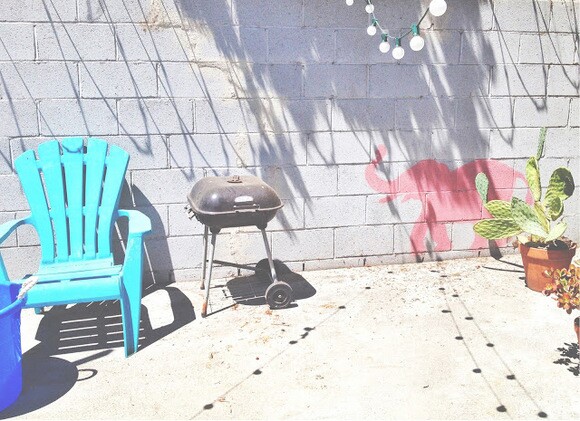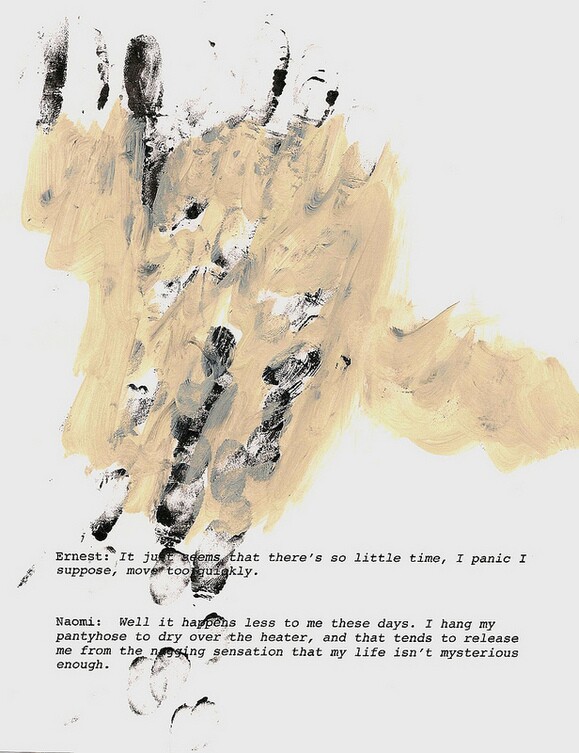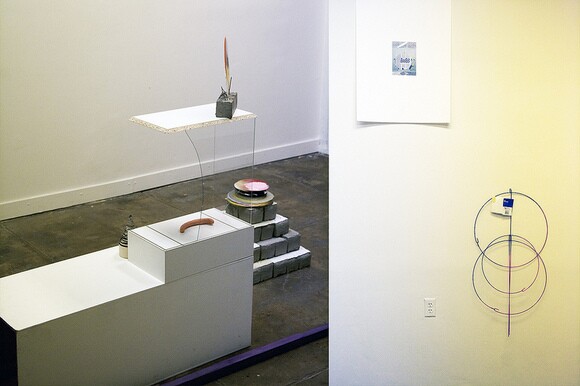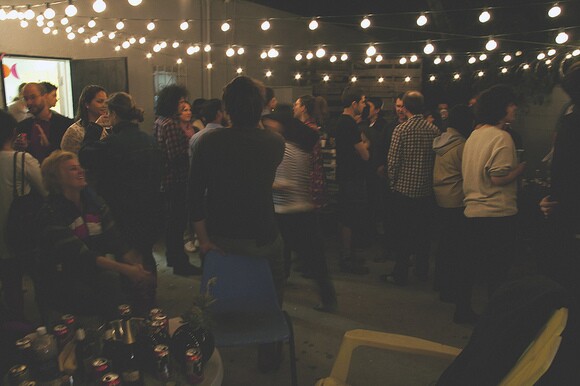Elephant Art Space: At Home in the Arts

Hubs & Hybrids is an ongoing series of interviews with those at the helm of some of L.A.'s most compelling artist-run and experimental visual and performing arts spaces.
We live in such a vast city, yet Los Angeles constantly surprises me with the remarkable moments of intimacy that can be found here. These moments often exist in isolation, little pockets of community, but also overlay one another with frequency, creating separate little worlds with overlapping concerns and values that rub up against one another unknowingly. The other day, a great artist and my friend Fritz Haeg, who is known for playing host to a number of generative, close, and welcoming conversations with artists and thinkers in his idyllic home (such as his legendary Sundown Salons and a more recent meeting of Hans Ulrich Obrist's Brutally Early Club) asked me if I knew of a little place "literally down the hill" from his home. "I think they're called elephant?" I couldn't help but smile, because the very same intimacy and hospitality that Fritz cultivates in his gatherings is at the core of elephant's ethos, and I had just interviewed them a week before. Funny he would ask me that, because the sense of welcome and community I felt there is so close to Fritz's own reading of what is unique and special about Los Angeles's art scene, which is the importance of a group of friends, of circles of makers, and of the conversations they engender to art production in this city. Needless to say, I urged him to visit and he thought he should walk down to say hi as well.
elephant art space is a big, boxy, gray building reminiscent of its moniker, with no markings except for a little gray elephant stenciled on the wall just below the flat roof. It really was the only place on the mostly residential Glassell Park neighborhood that could have been a studio space/artist-run gallery. Emi and I wandered through an open door into a very small white cube gallery with an odd door in one wall. Bianca D'Amico breezed in walking a beautiful border collie wearing a big floppy hat, and soon after Jason Kunke wandered in holding a glass bottle of coke. They both gave very warm and friendly welcomes, and invited us back, into what is essentially their second home. The narrow winding hallways revealed myriad studios and even more members of the elephant collective, a faux concrete block wall backdrop, and some odd leftover medical equipment, evidence that the building had previously been a medical office. In a weird twist of fate, even before that, the building had been Ed Ruscha's first studio. Overlapping tendencies, ignorant of the other, existing in the same space. We passed through a small kitchen with a mysterious hole in the ceiling, and what kind of looked like a dead body on the table with a newspaper over its head. It turned out to be a body puppet made for Zach Kleyn's recent performance, and it was clearly freaking everyone out to have it out on the kitchen table. A few more studiomates had appeared at that point, and we headed out together into the backyard, which is the beating heart of elephant.

Elephant functions like a series of residencies in the space, where a different artist each month does an exhibition in the front space and increasingly, programs in the back. They do other things too, like collective projects and group shows. But it is the relationships among the six artists that work in the space day in and day out that defines elephant. They truly enjoy each others' company, they are thinking critically and making decisions over beer at the local bar, with a constantly expanding group of friends, a circle of makers, engendering art production in this city. David Earle was off getting married, but the other five resident artists (including Astri Swendsrud, Quinn Gomez-Heitzeberg, Jason Kunke, Bianca D'Amico, and Matt MacFarland) sat down with us over muffins and peanuts for a conversation. They split responsibilities for the space loosely; Jason, as a founder of the space and the longest resident of the building answers emails and collects checks and does a lot of the curating, along with Astri and Matt. Quinn builds stuff, Bianca takes pictures and curates parties, and they all do a little of everything else as well. The space had its first show in 2010, and they do shows about once a month ever since.
Sue Bell Yank: So how did things get started? Jason, maybe you can talk a little bit about what was the impetus for starting the space?
Jason Kunke: I think we got the space early 2008. Me and a few other artists found the building, did all the demo. I didn't actually find the building, Cathy Akers and Luisa van Leer really were the spearheaders of finding the building and making it all into studios.
Bianca D'Amico: It looked so different, let me just say, because Jason invited me to have a studio space early on, and later I was able to get the space I wanted, but there was so much work to be done at the time, and what they did was tremendous.

Astri Swendsrud: It was a doctor's office building, and I never saw it at the very beginning, but even when I moved it, it was dramatically different. When I moved in in January we immediately started talking seriously about getting the gallery going.
SBY: How do you guys know each other, those of you who met later on?
All: CalArts [California Institute of the Arts].
BD: The grey floors really remind me of CalArts. It's very CalArtian. But I think what make this space so special is the backyard, everything ends up back here.
Quinn Gomez-Heitzeberg: It's so nice to have this backyard, this social space. We always have some beer for people. We almost always have hot dogs or something to feed people with. It's important for us to have that welcoming feeling. You know, come to our backyard, this is a space that we spend a lot of time outside of exhibition time, working in studios, this is our second home, and you are welcome here, come hang out and visit our space. So when people come to see the shows, they eventually filter back through all those little hallways and spill out here.
BD: Which leads to some artists being disappointed, they want people to stay in the gallery space, like, where did they go? People independently cruise it, though, they come back.
AS: There's a lot of flow in between the front and back.
JK: One nice thing that happens is normally when you go to a space where the only place to hang out is with the art, you can't see the art. You are always able to see the art here.
QGH: It really works well. That was not a planned thing, but it gives you a nice open space to see the things, and if you want to socialize you can socialize.
BD: Although the creepy body over there [a life-size puppet created by Zach Kleyn] did a performance on our bar, so a lot of artists want to get in with the crowd that's out here.
AS: We've had videos projected on the side of the building in the parking lot. We've had screens set up in the little alleyway on the side of the building and people doing projections.
SBY: So those of you guys who do a lot of the curatorial work, how have you seen it develop over time? What are some of the ideas you've been interested in over the past three years?
JK: I don't think we've really had a program.

AS: It's submission-based, basically. Occasionally we invite or encourage someone to...actually, it began with us inviting specific people to curate. Like artists who we thought would have an interesting idea for a show. We started mostly with artist curations, but since that time people have been submitting to us, and I feel like the main change that's happened is that we are now getting far more submissions than we can ever possibly show. We met this summer and planned the entire program till June in one meeting and had to reject or postpone some proposals that seemed potentially interesting, just because there wasn't time to deal with everything. We're also trying to do things like combine a performance in the back space while there's an exhibition in the front space. Last year we had several little one-night events or performances between shows, so we're trying to program as much possible but right now there are so many more possibilities than we can even facilitate.
SBY: And between you guys, now that you're selecting, what do you feel are the ideas that get you really excited?
BD: Parties. I like anything that really engages people.
Matt MacFarland: I feel like, more so than the last few years or so, people are really using the space, or making you notice the space in different ways. The installations are addressing the actual site a little more.
BD: I run my business out of the space and I'm always schlepping things back and forth, and the other day, I had to walk around giant slices of cake. Steven had put these beer boxes everywhere, so you never know. It's a really funny experience having to work in the space, and also having to deal with that front space being a place where anything can happen -- you never know what you'll have to deal with.
JK: You can simultaneously love the work and curse it because you have to step over things to get to your studio.
QGH: There was a consideration this time when looking at all the submissions because the people who understood elephant, who had been here, who knew what they were getting into, I think we lean towards a lot of those submissions.
AS: People who have a sense of investment.
QGH: People say, you know, I have paintings that are ready to go. But it's a very small gallery and there are doors in it, and a lot of people that haven't been here and don't know the vibe and the feeling of it, that could be a surprise for them or not be a good fit for us.
AS: We have a painting show up now and it's great in the space, but it's an artist [Caroline Kent] who runs her own artist-run space in Minneapolis and was really engaged, and has been following what we've done here from a distance and was really interested in making her work an appropriate selection for the wonky space that we have here.
BD: We aren't selling anything here, so I think that what makes us open to something super ephemeral, or a one-night thing, that's what excites me about the space, that people can do amazing art without being packaged up and ready to sell. It can be super temporary.
JK: We're not really curating per se. When I'm interfacing with an artist I let them know their proposal is perfunctory, it gives us something to look at and think about, but once they're in, they can do whatever they want with the space.

AS: Keys for the month that their show is up so they can have meetings, they can use the space however they want. Miggie Wang, who did the show last month, programmed events for every Saturday of her exhibition. You know, we can't necessarily promise to be here every Saturday but as long as you promise to clean up the space afterwards you can basically do whatever you want during that time. So she had bands and performances and different events.
BD: A lot of dessert. I got a cavity during her show. That's also really fun is just having different people here while you're working. There were -- I'm sorry, I'm going to bring it up -- The Austrians. These gorgeous men without their shirts making sculptures out here in the hot sun for days. I was like "Yes. This is the greatest place to work ever."

AS: It was like a total spatial installation for the gallery.
JK: The art was also good-looking. And shirtless.
SBY: So besides your website, your newsletter, are there any other support mechanisms for the artists who come here?
AS: We have our mailing list which is constantly growing. We always send out an email announcement, there's the Facebook page, that kind of social media.
BD: I would say that having the photos of the show after is something special we do for the artists, in that, if someone misses the show, we have all the photos.
AS: Caroline [Kent] was so excited, as she was installing, she didn't realize we were going to document everything from her opening, she was so thrilled. Well, Caroline's lovely also.
BD: It is cool because as we were first talking about the website and shooting photos, the photos are often just like, a pile of beer bottles or whatever. I think it's really important to keep the photos as casual and as intimate as it is to actually be here, so they're generally not really formal basic shots, they're still stylized, but they're intimate.
AS: I like the way capture the whole event that goes on, not just "here are the works in the gallery."
SBY: It's definitely more than just giving them the keys, there's infrastructure. So who would you say often shows up to your events?
MM: We have regulars for sure.
AS: We have a good core group that shows up for everything, there's always a good core group of elephant attendees, then there's also, it does vary show to show based on the artist. We just showed an artist from Minneapolis, we showed the Austrians and the Irish guys, but mostly it's been LA-based people, a few people from Texas back a couple times. I've also noticed though that a lot of the artists who show here come back for almost every show.

BD: They kind of join the family, which is how (artists) Steven [Bankhead] and Jesse [Benson] invited us to show out in the desert. And also, the neighborhood kids have been coming. His name's Jesse, actually, is the one that's always down here and he invites all his friends and he's really cute cause he's actually an aspiring photographer, and we had one of these crazy performance nights, and he actually did most of the photos for that night, and video. He did a great job. He's really cool.
SBY: How else do the neighbors react to you guys being here in this residential neighborhood?
BD: [pointing to the apartment building visible over the backyard wall] We talk to them all the time, they're awesome, and the ones next door, we had a big party and he said "Oh, you have a good time?" and we said "Sorry about the noise!" and he was like "Oh, you are all painters and poets?" And we were like "Yeah! Painters and poets!" and he was like "Oh, a painters and poets party, that's good!" We love that neighbor.
JK: We don't go too late usually.
AS: It's amazing how little you can hear from the street. When Zach was DJing here the other night I was out in the front and someone was asking "Is he still performing?", because you can't hear it really. The yard contains it remarkably well.
BD: There was a guy who came to our last performance with a little dog, he had just been walking by, and he was like "I saw it was open, so I wanted to come in."
SBY: So, pulling back from the space itself, how do you locate it in relation to other spaces in LA or see yourselves as part of a larger ecology?
JK: Well, David Earle, the fellow who's not here, also helps run Monte Vista Projects, like a double agent. I think structurally we work a lot like Monte Vista Projects.
MM: We've shown a lot of the same artists. We're kind of like cousins.
JK: It's interesting because there are so many artist-run spaces. There's the little community around elephant that's part of this bigger community of spaces.
AS: I feel like this backyard space really distinguishes what we do in the midst of it, just because it is so communal and so social, that people come here and stay. We had people who showed up at 7:00 at the opening on Friday night and didn't leave until 12:30, once everything had finally shut down. They'd been here for 5 and a half hours.
QGH: I think elephant shows are fun. We want it to be enjoyable. Some galleries you go, and you do your duty to see the work and then you socialize in that hot, small gallery space and then you go, but we want people to come and be comfortable here. I think it's a welcoming place, you know, if we have a role it's as a very friendly gallery.
SBY: Are there other spaces that you guys really admire, frequent a lot? I don't know if you've ever collaborated with other spaces?
JK: Actually, one of the last shows we did this year was Steven Lapthisophon. That was a fun show, he's an artist in Texas, he's an older artist, a Pictures Generation artist. Our acquaintance Vincent Ramos was in touch with him, they'd been in a show together and stayed in touch, Vincent really liked his work and asked him out to LA to do a show. I guess he had never had a show in LA.
AS: He had never been in LA before. He'd never even visited, so the show was partially about his imaginings of what it was like.
JK: So Vincent did all this groundwork, putting out proposals to different spaces, and Actual Size had a slot at the time. So he did a two-part show basically, at Actual Size and here, one show but two different bodies of work essentially. There was one title but each space had its own subtitle. That was great, that was a lot of fun. I really like what Actual Size does, it's a gorgeous space.
AS: I guess we also collaborated with Shangrila.
BD: That was a blast.
AS: That was just Labor Day Weekend. Shangrila was in Joshua Tree. This year it was curated by Jesse Benson and Steven Bankhead who had both shown here, and so they invited Elephant to do something as a part of that. It was very open-ended. They mentioned it to us months in advance, and then no word until we saw our name on the list of participants a month before the event.
JK: We basically built a stage for all the events.
BD: We made the stage look just like our backyard.

QGH: We were trying to think what we could contribute to it, and we were thinking, what do we do here, we give people a space, we provide an opportunity to do things. Well, maybe we can put a stage out in the desert, everyone can do whatever they want. We ended up building the stage for all of the performances for the whole thing.
AS: We brought the cactus. We brought these stacked chairs. We ran wire. We decided not to use actual razor wire. We just ran wire across the top of the stages.
BD: They were like "Is this prison themed?"
AS: People who hadn't been to our backyard were baffled. Everybody who knew our space were like "Oh my god, this is exactly your backyard!"
JS: That's funny that our first opportunity to build a physical thing all together was just a mimetic representation of the social thing.
SBY: We've found that a lot of the spaces we've profiled started in 2010, like Actual Size, the Museum of Public Fiction, they're all about 3 years old, and it seems to be there were a bunch of spaces in 2005 that are now old-guard, like Machine Project or LAXART, or spaces like that. Do you have any thoughts on how these cycles happen?
JS: It felt really pragmatic. For me personally, I was doing undergrad in Houston, and I was always part of a DIY show your work, show your friend's work kind of thing that was happening so it never felt odd to keep doing that. But there is definitely more art than places to show art. I'm not breaking the Da Vinci code there or anything. We all know that.
AS: Just making a place that's available and accessible to people.
BD: I think it also has selfish perks too. Having a place where there are other people showing work - there's a social advantage of having other studiomates, that's great. But having the activity of people constantly coming and going and being here, and having that life, it fills you up and excites you, as opposed to it just being a studio space. Relating to LA specifically, too, I have a lot of friends who have studios in their homes or by themselves, and they get lonely. They don't have that engagement. I think that was a major motivation for me. I should probably go look for a bigger studio, I really should, but I love it here because of all that social opportunity.
MM: I feel like what makes the space sustainable too is that we like being around one another and we enjoy each other and it's pretty easy. I feel like that's why some spaces peeter out is because the dynamic doesn't work out anymore.
QGH: Yeah, it makes it easy to run the space when you like the people. I mean meeting up is not a trial because we can get together and chat things out and it all flows well.
Sue: Do you have aspirations? As people cycle out or move on, where do you think it will go?
BD: We don't really have that conversation amongst each other, we keep maintaining it, we keep maintaining it, and things improve and get better, like Matt took over and did a real newsletter on Mail Chimp for us. Woo-hoo! Why didn't we do that before?
AS: I know, Quinn patched the hole in the wall that's been there for years!
BD: These improvements happen and we get excited. But we never sat down and wrote down our future.
AS: We never sat down in the first place and said, "Okay, we are going to open a gallery space with these goals and we all want to be gallery directors first and foremost," it was really just more pragmatic, wanting to bring people together and be part of our space. Everything happens organically, we are all busy, we all have our own practices and businesses and teach and work...
BD: And weddings, a lot of weddings.
AS: But we're not out there to turn this space into anyone's main project.
QGH: It does keep getting better, and it keeps getting easier, and it keeps making sense, so we keep doing it.
BD: I like that, it just makes sense.
JK: And as long as people show up, that's what it's all about.
QGH: Yeah, as long as people enjoy themselves and artists show up and they get something out of it, that's why we keep doing it. I mean, it costs us time and it costs us money, it doesn't make anything for us, but it's worth it. We enjoy it, and they enjoy it, and that's enough.
Dig this story? Sign up for our newsletter to get unique arts & culture stories and videos from across Southern California in your inbox. Also, follow Artbound on Facebook and Twitter.


